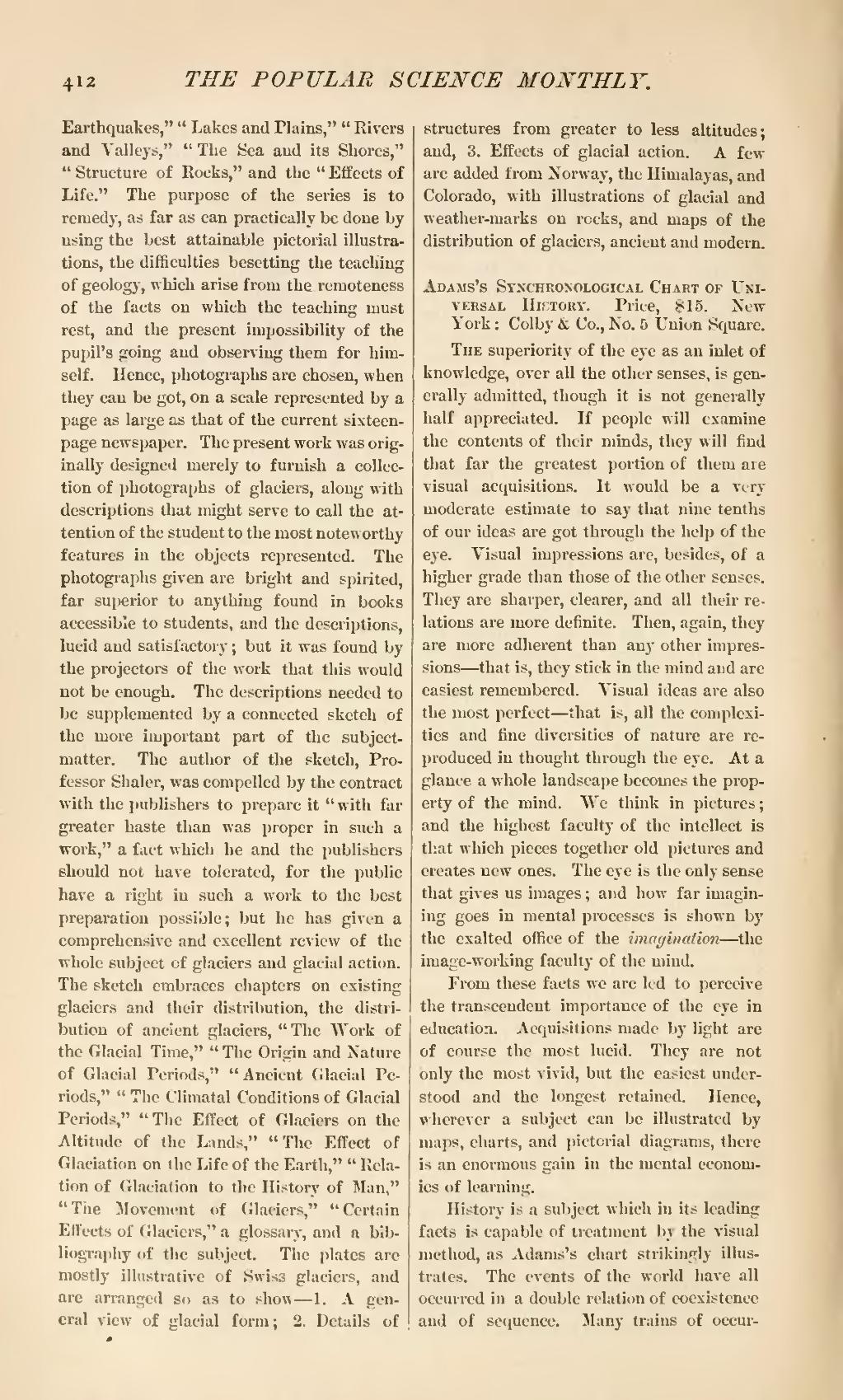Earthquakes," "Lakes and Plains," "Rivers and Valleys," "The Sea and its Shores," "Structure of Rocks," and the "Effects of Life." The purpose of the series is to remedy, as far as can practically be done by using the best attainable pictorial illustrations, the difficulties besetting the teaching of geology, which arise from the remoteness of the facts on which the teaching must rest, and the present impossibility of the pupil's going and observing them for himself. Hence, photographs are chosen, when they can be got, on a scale represented by a page as large as that of the current sixteen page newspaper. The present work was originally designed merely to furnish a collection of photographs of glaciers, along with descriptions that might serve to call the attention of the student to the most noteworthy features in the objects represented. The photographs given are bright and spirited, far superior to anything found in books accessible to students, and the descriptions, lucid and satisfactory; but it was found by the projectors of the work that this would not be enough. The descriptions needed to be supplemented by a connected sketch of the more important part of the subject matter. The author of the sketch, Professor Shaler, was compelled by the contract with the publishers to prepare it "with far greater haste than was proper in such a work," a fact which he and the publishers should not have tolerated, for the public have a right in such a work to the best preparation possible; but he has given a comprehensive and excellent review of the whole subject of glaciers and glacial action. The sketch embraces chapters on existing glaciers and their distribution, the distribution of ancient glaciers, "The Work of the Glacial Time," "The Origin and Nature of Glacial Periods," "Ancient Glacial Periods," "The Climatal Conditions of Glacial Periods," "The Effect of Glaciers on the Altitude of the Lands," "The Effect of Glaciation on the Life of the Earth," "Relation of Glaciation to the History of Man," "The Movement of Glaciers," "Certain Effects of Glaciers," a glossary, and a bibliography of the subject. The plates are mostly illustrative of Swiss glaciers, and are arranged so as to show—1. A general view of glacial form; 2. Details of structures from greater to less altitudes; and, 3. Effects of glacial action. A few are added from Norway, the Himalayas, and Colorado, with illustrations of glacial and weather-marks on rocks, and maps of the distribution of glaciers, ancient and modern.
Adams's Synchronological Chart of Universal History. Price, $15. New York: Colby & Co., No. 5 Union Square.
The superiority of the eye as an inlet of knowledge, over all the other senses, is generally admitted, though it is not generally half appreciated. If people will examine the contents of their minds, they will find that far the greatest portion of them are visual acquisitions. It would be a very moderate estimate to say that nine tenths of our ideas are got through the help of the eye. Visual impressions are, besides, of a higher grade than those of the other senses. They are sharper, clearer, and all their relations are more definite. Then, again, they are more adherent than any other impressions—that is, they stick in the mind and are easiest remembered. Visual ideas are also the most perfect—that is, all the complexities and fine diversities of nature are reproduced in thought through the eye. At a glance a whole landscape becomes the property of the mind. We think in pictures; and the highest faculty of the intellect is that which pieces together old pictures and creates new ones. The eye is the only sense that gives us images; and how far imagining goes in mental processes is shown by the exalted office of the imagination—the image-working faculty of the mind.
From these facts we are led to perceive the transcendent importance of the eye in education. Acquisitions made by light are of course the most lucid. They are not only the most vivid, but the easiest understood and the longest retained. Hence, wherever a subject can be illustrated by maps, charts, and pictorial diagrams, there is an enormous gain in the mental economics of learning.
History is a subject which in its leading facts is capable of treatment by the visual method, as Adams's chart strikingly illustrates. The events of the world have all occurred in a double relation of coexistence and of sequence. Many trains of occur-
